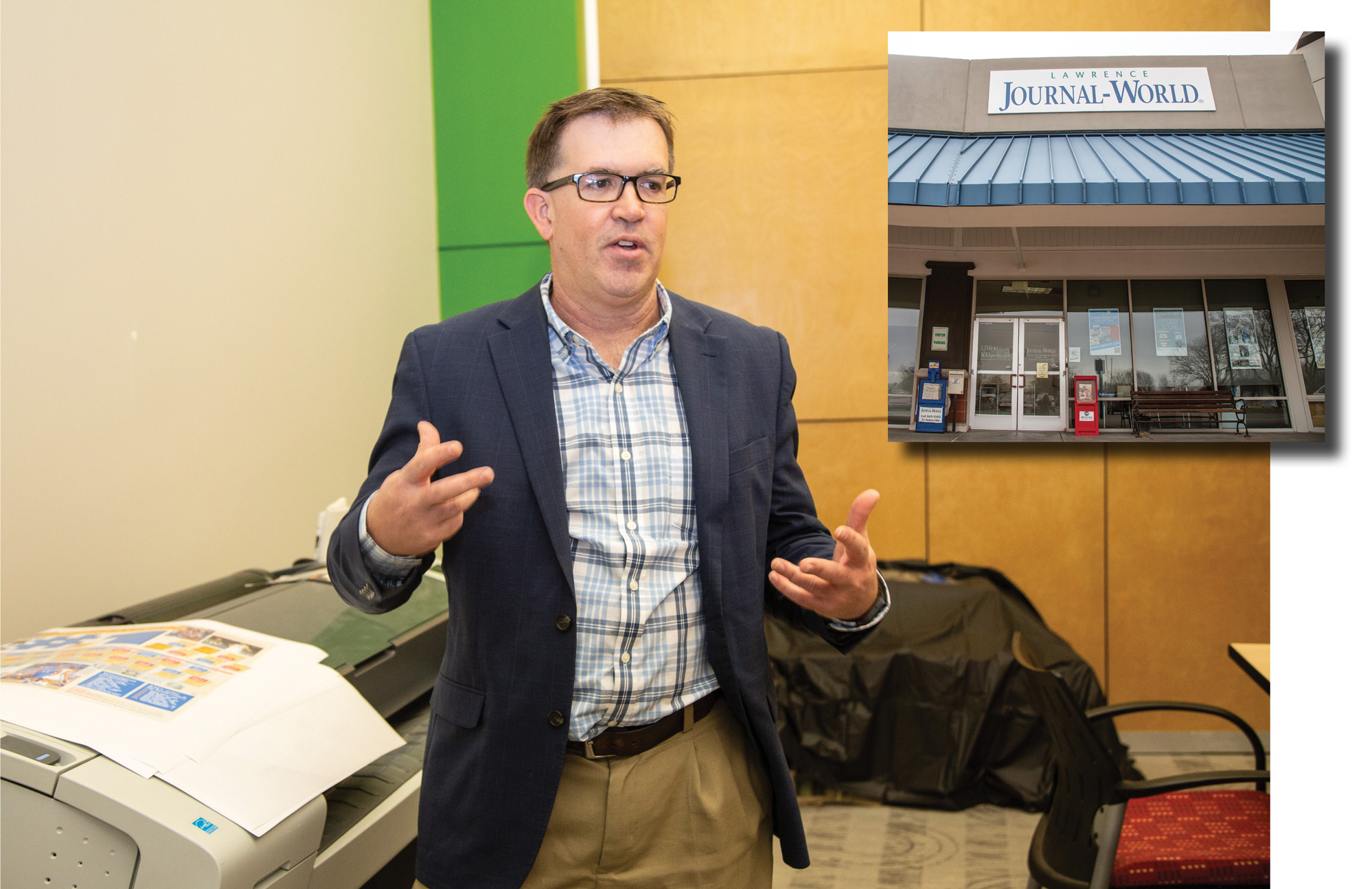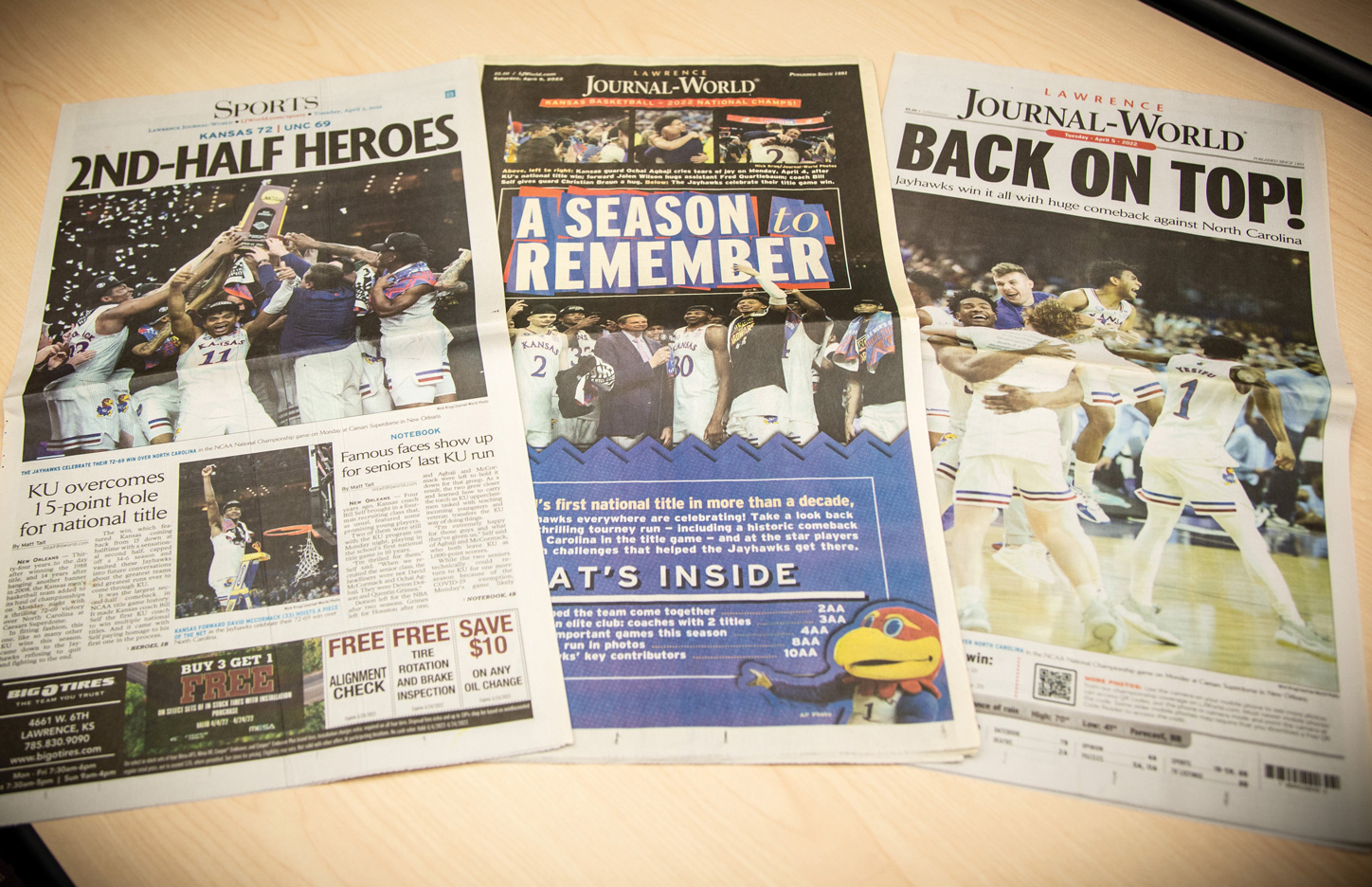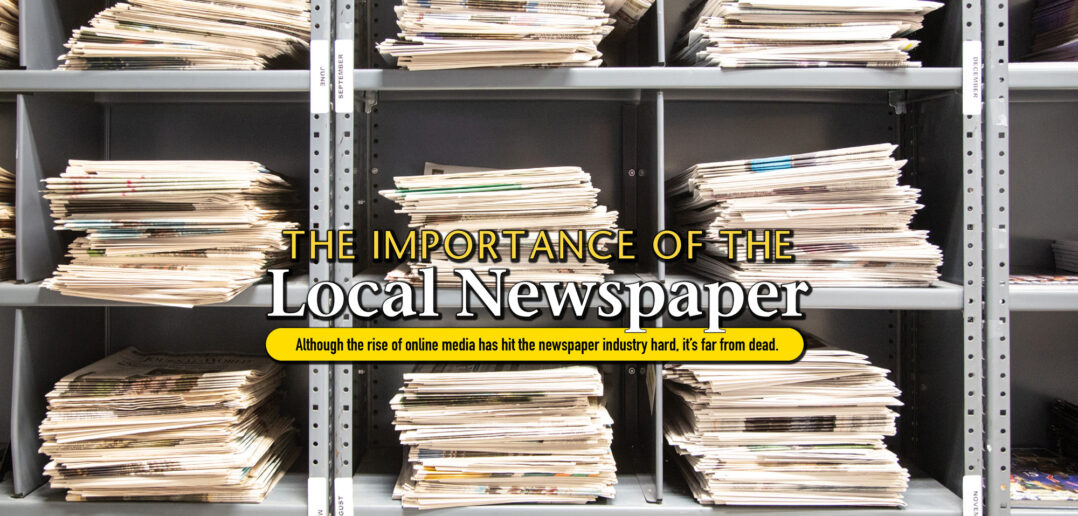| story by | |
| photo by | Steven Hertzog |
| OPEN A PDF OF THE ARTICLE |
Although the rise of online media has hit the newspaper industry hard, it’s far from dead.

Chad Lawhorn, editor and publisher of the Lawrence Journal-World
Newspapers are a critical part of American culture and have been for decades. Recently, however, they have been hit hard because of the trend toward digital media. Newspapers have been losing revenue, and their subscriber bases have been declining since the mid-2000s. The bright side is that their online traffic has begun to grow, helping those who are willing to follow current trends.
The New York Times reported in June 2022 that more than 360 newspapers had closed since the pandemic began, at the same pace as before the pandemic (about two per week). The initial fear was that the pace would increase because of the pandemic, but that hasn’t happened. The pace has actually remained steady, The Times explains, and that, in itself, is not actually good news. Since 2005, more than 2,500 newspapers have closed, and the country is set up to lose a third of its newspapers by 2025. In addition, many media giants, such as Gannett, have had to cut staff and circulation, and shut down failing newspapers.
“The newspaper industry has changed a lot over the years,” says Chad Lawhorn, editor and publisher of the Lawrence Journal-World (LJ-W), which publishes a print edition six days per week except for Monday and has about 20 full-time employees, half journalists and half in departments such as advertising, circulation, customer service and other areas. “That is why it is important that we evolved many years ago into a much broader media company.”
He explains that some people who used to get their information through print media now get it solely online, but many use both. “We are fortunate that Lawrence cares about news. It is a community that likes to get involved with issues, and having access to accurate information can be a key to that involvement. At the end of the day, that interest adds up to good audiences for us.”
According to the Reuters Institute report “Journalism, media, and technology trends and predictions 2023,” by Nic Newman, senior research associate at the Reuters Institute for the Study of Journalism, news organizations that have not yet embraced digital will be at a severe disadvantage. “The next few years will not be defined by how fast we adopt digital but by how we transform our digital content to meet rapidly changing audience expectations,” he explains.
The Institute surveyed 303 media leaders in 53 countries, including 68 editors-in-chief, 49 CEOs or managing directors, and 44 heads of digital or innovation from some of the world’s leading traditional media companies and digital-born organizations. The survey concluded less than half (44%) of the sample say they are confident about their business prospects in the year ahead, with almost as many (37%) uncertain and around a fifth (19%) expressing low confidence.
According to the same report, 2023 will see more newspapers trim down or even stop seven-day-a-week publications. Distribution networks will weaken. Digital subscriptions and bundling will continue to increase, and the focus will be on keeping existing customers rather than adding new ones. Price cuts, special offers and longer trial periods will become prominent, and media outlets will put a spotlight on their mission and the quality of their journalism. Having multiple revenue streams, such as subscriptions, funding from tech platforms, display and native advertising, events, ecommerce, donations and philanthropies will all become much more important.

Chad Lawhorn, Publisher/Editor and Writer of the Lawrence Journal World- Lawrence Journal-World
Community Watchdog
The functions of a strong news operation are essential to a thriving democracy, where reliable reporting and informed commentary keep people abreast of the life of their community, explains William McKenzie, senior editorial advisor at the Bush Institute, in its journal “The Catalyst.” But internet and social media platforms have drastically changed the news business. “On the positive side, new technologies have given consumers instant, direct access to innumerable sources of information,” he explains. “On the negative side, consumers have little reason to pay for traditional news reporting if they can get information free off the internet and from social media.” But then, there is no guarantee the information is factual, reliable and vetted by trained journalists.
“When we don’t have local journalists who can cover local open meetings, decisions and power structures can operate unwatched,” says Virginia Musser, research project coordinator at the Center for Public Partnerships and Research, the University of Kansas (KU), and a graduate of the KU School of Journalism. “Local publications should be the people who stand up and say ‘This isn’t right’ about something in the community. It’s up to them to amplify marginalized voices and keep elected officials accountable for their actions.”
LOCAL MATTERS
Our Local Advertisers – Making a Positive Impact
Lawhorn agrees. “While the websites have changed much about our business, the core aspect of our business remains the same: We make our living by providing accurate, timely, important and, hopefully, interesting information.”
He says the most important part of the equation is the information going through the journalistic process. “There’s lots of information floating around in the world. There is no shortage of information in today’s society,” he adds. “There is a shortage of information that goes through the journalistic process.”
Lawhorn explains the journalistic process involves journalists who follow a certain set of ethics: It involves copy editors who are checking information before it is published; it involves rules and standards about how we source information and much more.
“Hopefully, what we bring to the community is information that people can trust. Our job really isn’t to try to get you to think a certain way or sign up for a particular cause. Our main job is to gauge the interests of the community, take the time to learn and understand those interests in a meaningful way, and then provide the public with information in a manner that the public can trust is accurate and appropriate.”
Musser agrees. “Ideally, a print publication will help a community stay connected,” she explains. “A print publication can curate the presentation of subjects in a way that exposes you to news you might miss if you were just scrolling through your own news feed. It’s a historic artifact of a community’s daily life as opposed to a flickering page online.” Both ways of preserving information are critical, she says, “but no online site will ever beat the feeling of holding a newspaper in my hand while reading the day’s news.”
Lawhorn says he understands the importance of providing accurate and appropriate information to community members, and though the paper may not always hit the mark, it remains important to his team each and every day. “I’m fortunate to work with a great staff that really takes it to heart.”

Local Celebrations – Lawrence Journal-World
Quality Is Key
In the past, there were few ways to get local information other than through a newspaper, but technology has created many ways information can be delivered to consumers, Lawhorn explains. “That’s good. Choices are good. Our challenge is to make sure the information we are providing is high quality. Then it becomes like Coca Cola in a bottle or Coca Cola in a can. People may have their preferences, but as long as it is Coca Cola, it is going to sell pretty well.”
And challenges such as costs—materials, gas for delivery, the price of newsprint and labor—can pose a challenge, he continues. But other businesses, not just print media, also face similar challenges. “None of that, though, has diminished our commitment to publishing newspapers. A newspaper is still a very popular product both with subscribers and advertisers.”
Lawhorn says lots of subscribers have a personal preference for a newspaper. “They like opening up a paper … rather than plugging in a laptop. They like that a newspaper doesn’t hurt their eyes like the glare of an electronic screen does. They like how we organize the content of the paper. There are all types of preferences like those that are perfectly legitimate reasons to prefer a printed newspaper over one of our websites. … We are very pleased that newspapers remain popular with readers.”
So who is the target customer for print newspapers?
“I think, honestly, it’s mostly people my age and older who still remember what newspapers used to be,” Musser explains. “But it’s like reading a book: Some people are just always going to prefer holding a physical object in their hands.”
She says she hopes print and digital media can coexist, because we need them both. “The digital divide is real, and it’s not going away anytime soon. If information shifts to all-digital presentation, who are we excluding?”
One example, Musser relates, is a school that has an online newspaper instead of a printed newsletter. “How are families going to stay connected? Most of the middle-class world has no problem pulling out a phone and getting online. But what about other socioeconomic groups? Is it easy for families who are struggling with making it through each day?”
Digital equity is critical for civic participation, for community participation, for education and for access to essential services, she continues. “And right now, we’re looking at a community where high-schoolers will no longer have access to laptop computers, so I’m not feeling very optimistic about digital equity happening without a lot of advocacy and insistence.”
Embrace Change
Lawhorn explains that newspaper media is like any other business in that it must evolve and change its practices to get its fair share of a person’s time and money. “But we are in a good place to do so,” he says. “We really do interact with tens of thousands of area residents every day. Very few local businesses can say that.”
Some changes the Journal-World has embraced recently include requiring users to pay for news content online. “I’m a fan of that change,” he says. “I’ve come to believe that if you think local journalism is important, you have to believe in it enough to ask people to pay for it.”
The LJ-W requires a digital subscription to access most of its content on LJWorld.com. It provides free access to the website at the Lawrence Public Library, and certain articles are also provided for free. “That’s basically the same model that has served the publishing industry well for a long time (bookstores don’t give their books away for free),” Lawhorn explains. “But the newspaper industry deluded itself early in the internet age that it could give away its content and simply rely on internet advertising to pay the bills. Ultimately, I don’t think anyone ends up being very well-served by that.”
In 2022, a year when many subscription-based businesses struggled ,the LJ-World posted digital subscription growth. Just recently, it introduced a redesigned website for KUsports.com, a great improvement over the last website. Late last year, staff did a redesign of the Tonganoxie Mirror website, and they continue to experiment with video. The LJ-World also has more than 31,000 followers on Facebook and almost 40,000 followers on Twitter. “We have to be a business that can meet people’s information needs in the manner they most prefer. That always will be a work in progress,” Lawhorn says.
Traditional advertising remains on the scene, as well. For advertisers, he explains, the nature of the newspaper makes it attractive in ways that some other media can’t. People who read the newspaper usually pay around $20 a month to get the paper. “That is a good sign that they are going to spend some time with it. If you are trying to get people to notice your ad, having a product that people spend time with is a real positive.”
Plus, newspapers continue to have a great tradition of saving people money through the coupons, Lawhorn adds. “We still deliver $100-plus worth of coupons many Sundays. Lots of people actually buy newspapers because of the ads that are in it. Those are very valuable customers for local businesses.
“Trying to figure out how to meet the different needs of those different types of readers can be very challenging, but it also makes it very rewarding,” he says. “We are very glad that people still care greatly about what we do.”




